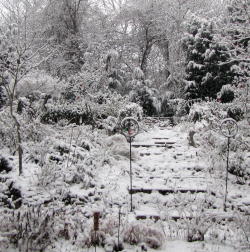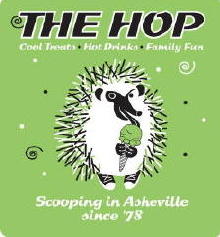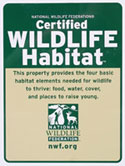
The year 2010 is one half over. It is time for a performance review of the redesigned lawn, first conceived in August of 2009. Read the history about its conception by clicking here-The Lawn Experiment-Open To Suggestions.

We will travel backwards in time, beginning with now, the end of June view of the lawn area from the street. This is the west side of the property, where the circle drive exits. There is a stand of mature Loblolly Pines, not in this shot, at the property edge with shrubbery underneath. Moving east finds the lawn with the Fairelurie that contains the wide border of pink Muhly grass, Muhlenbergia capillaris, not shown, on street side, just to the right of the junipers at the bottom of this photo. The Fairelurie will be the subject of its own performance review later in the season. There is a five foot wide curving gravel path, another garden area, then the garage. Between the lawn and the garden, in a line that is even with the back of the garage is a hedge of Arborvitae for privacy, this you can see.

The latest tweaking has been to allow two of the mowed paths to fill in, letting the lawn grass grow untamed with various wildflower seedlings added as they become available in the gravel paths. So far, Verbena bonariensis, Leucanthemum vulgare, Salvia coccinea and Prunella vulgaris babies have been stuck in the now free to be itself grass.

Six store bought Rudbeckia hirta ‘Prairie Sun’ were added at the front edges to keep people from walking on the newly designated wild meadow type areas while they grow to the same height as the original fans.

Continuing in the backwards groove, twenty Longiflorum Asiatic Lilium ‘Royal Sunset’ were planted in March and have just finished the June blooming. Four each were planted in the lawn fan shaped segments, marked with stakes topped with the little onion finials.

Without the lilies to add much needed color, the lawn looks quite messy, chaotic even. Scads of seeds were scattered in there, but the thick grasses seem to have prevented any germination. A new paradigm is needed.

Going back to mid May, four of these red Celosias, (they look sort of like Amaranthus but the tag said Celosia), no cultivar name on tag, were added along with eight Celosia spicata ‘Flamingo Feathers’. It should have been four hundred, or maybe forty, or even twenty, for these two are the stars of the season. Next year we will might remember to add more of these if they can be located for a reasonable price.

In early May, just before we left for England, the Allium ‘Mount Everest’ proved to be disappointing. They reminded me of giant dandelion seed heads, there were too few, a recurring complaint, and just did not stand out well against the green grass. About the grass however, we had no idea how tall the lawn grass of Kentucky Bluegrass and Tall Fescue would be in bloom, or how it would appear. It turned out to be about eighteen inches to two feet tall and quite attractive to our eyes. When the lawn experiment was begun last summer, the bloom period was already past for the grass and the growing season was nearly over so there were questions about how unmown lawn grass would behave.

In late April the Alliums held great promise. I actually like them better at this stage. The tulips are still in color.

In mid April the flowering period of Tulipa batalini ‘Apricot Jewel’ was beginning. This endeavor should be considered a success. The height, color and bloom time were perfect. Of course more are needed but we think it best to see how these return before spreading these about or ordering more. Two hundred and fifty bulbs were placed in twelve holes along the wide edge of each fan, three holes per. It was the effort of digging that guided this design. I was tired.

Before the tulips opened, the Anemone blanda ‘Blue Shades’ were a delight. There are no complaints at all about these except that we need more. They have been spread about some right after the bloom was over. After seeing how they fare next year, more might be added. The bulbs are small and easy to plant. The cost is less than the tulips and the return should be more reliable. I love the blue with the brilliant green of the young spring grass and there was overlap with the yellow tulips blooming.

In March, just as the grass was beginning to grow, small patches of Puschkinia scilliodes var. libanotica alba are in bloom. These are tiny in stature but glisten like starlight among a green sky.

We end with the beginning, January. The lawn fans are freshly mown, ready to begin anew. In this shot, the pine trunks, shrubs, the neighbors house, the gravel path, the Arborvitae and even the corner of the Fairelurie are in view along with the four lawn fans. Imagine the two side paths with taller grass and just the middle path shorter, as it is now. It seemed that the fans were too small and the grass was flopping over the paths, making mowing troublesome, as was dragging the extension cord around the finial stakes for the electric mower. They can be mown short again if that seems a good idea in the future for there are no bulbs in those areas. Yet.
Overall, the plantings of bulbs were good, even if not enough of them were put into the ground. Digging holes to plant anything has proved to be daunting. Under the layer of compost that was spread at the time of lawn seeding is the old gravel driveway of the house next door that was purchased, torn down and the garage built in its place, slightly closer to the main house. Compacted from years of vehicular traffic, this area will never be a fertile bed of loose, light loam. The grasses are doing well and tough daisies and the tall Verbena look good. Scattering seeds was a total failure however, unless some of them germinate next year when the grass is again cut short in January 2011. The bulbs add some zing and more could be added, but the expense, not to mention the poor soil might prohibit that. We look forward to seeing what the second half of the year will bring.
Frances









Good morning Frances, I do think that area turned out very well. It sure looks great to me!
Frances, I think the first 6 months has been good, this always was going to be a long term project. I think it is good that the ground isn’t too fertile, as this gives the flowering plants chance against the grass. By this time next year you will have more idea about what is going to return and spread each year. I find Anemone blanda is a good self-seeder, I was surprised how many came up in the second year. I think it will look more untidy as the year goes on but that is only natural. Thank you for sharing this very interesting project with us.
Best wishes Sylvia (England)
I think it is a good experiment. I have wanted to do something similar in the front of our house but my DB is totally against it. It goes against his neat gene. Have fun in Buffalo. I hope you take lots of photos. I can’t wait to see them. It sounds like there is a full schedule.
Good morning Frances!It was interesting to look at this place in reverse! I think it looks unusual, different in a good sense, not typical. It has a character! Love all the flowers. Have a great trip and bring back lots of pictures. I visited several outstanding, inspiring gardens lately. The last visit was to the garden of Little and Lewis. I just posted about it. Will wait for your after-the-trip posts!
It will be interesting to see what happens next year. Growing in grass must be quite tricky – finding out which plants thrive and which go all huffy and disappear for ever. Lets hope that the star plants are the ones that get established. A gardener can never take anything for granted which is what makes it fun!
Regards Denise
I remember when you first started this project, Frances, and I’m so glad you showed us how it turned out. I think the first year of any new garden area like this is trial and error; not everything works out as you planned, but there are always surprises. I think it looks great, but I sympathize with dealing with the soil and all the digging. I seem to run into a layer of gravel every time I dig in a certain area here where the old house once stood. That kind of digging can sure wear you out fast!
Have a great time in Buffalo, and be careful about accepting rides from strangers:)
It looks very pretty, especially the lilies. Our HOA would freak if we did that with our front grass, but you seem to be out away from the neat little subdivisions where you can be more wild and have it work well. I keep looking at the low-growing, drought tolerant turf grasses in the High Country Gardens catalog. We won’t go for the meadow look, but eventually I’d like to try to do turf with less water and less mowing.
Frances, Everything looks so nice! And I like time travel! Have fun in Buffalo.
We tried letting a patch go to meadow one year. I looked fabulous, with the grasses shimmering in the light. As the 4th of July approached, our neighbor worried about fireworks setting the drying grasses on fire, so we mowed it down with a scythe. The cleanup was backbreaking, and R said “never again”. I will satisfy myself by looking at yours…lovely!
An interesting experiment. It takes guts to go natural- I find people have very strong opinions pro or con natural. I myself love the idea of attracting birds, butterflies and other creatures back into our urban environment in a more natural garden. I must tell you, and I hope you for being honest and not simply writing,”It is a lovely garden”, as so many bloggers do, that I find the lilies stand out too much from the fine, delicate stalks of grass. The seem out of place. The thick stems are not balanced out with anything similar. If it were me, I would add black eyed susans and echinacea or some other perennial with heftier stems to balance things out more. Just a thought. Happy gardening!
I like the way this has turned out. I also was very interested when you first proposed the project. I tried a wildflower strip along the street here, but ran afoul of the City’s ordinance regarding acceptable height. They feel that no lawn should be taller than 8 inches and will have their crews mow you if you disobey, subsequently billing you for the privilete, of course. After I discussed the fact that this was “not” a lawn but a wildflower garden several times with them, I finally gave up.
It will be interesting to see how your forbs compete with the lawn grass. Around here the grasses in the lawns are so powerful that it takes a very strong plant to compete with them. It looks like your grass variety is a little less overbearing.
At any rate, it is turning into something quite beautiful. And I am interested in how the flowers will reseed.
Oh my gosh, Frances, I was just strolling through comments and saw your reply–I can’t believe I forgot Ringo’s birthday!! I don’t even want to think about how old he is; I prefer to think of him with the rest of the Fab Four and myself as that infatuated 14-yr.-old of long ago:)
Love that mown-through-the-meadow look.
I absolutely love the combination of grasses and lilium. I’ve always been stuck with the idea that grasses only work with other grasses but plantings like yours are sweeping that notion away. Beautiful.
Quite an art form lawn design!
That’s an interesting presentation, since the usual is from a bare spot to full bloom. Makes you appreciate the progression more I think. A very beautiful garden. 🙂
A great experiment you’ve started. I need to visit more often:) For what it’s worth the Celosia ‘Flamingo Feather’ has self seeded in my garden for many years- my guess would be @ 8.I haven’t had alot of it in recent years but a few seedlings are growing up against the house right now. Bloom usually doesn’t begin until late August from these volunteers.
Pingback: Shopping For Plants In Your Own Garden-Continued… « Fairegarden